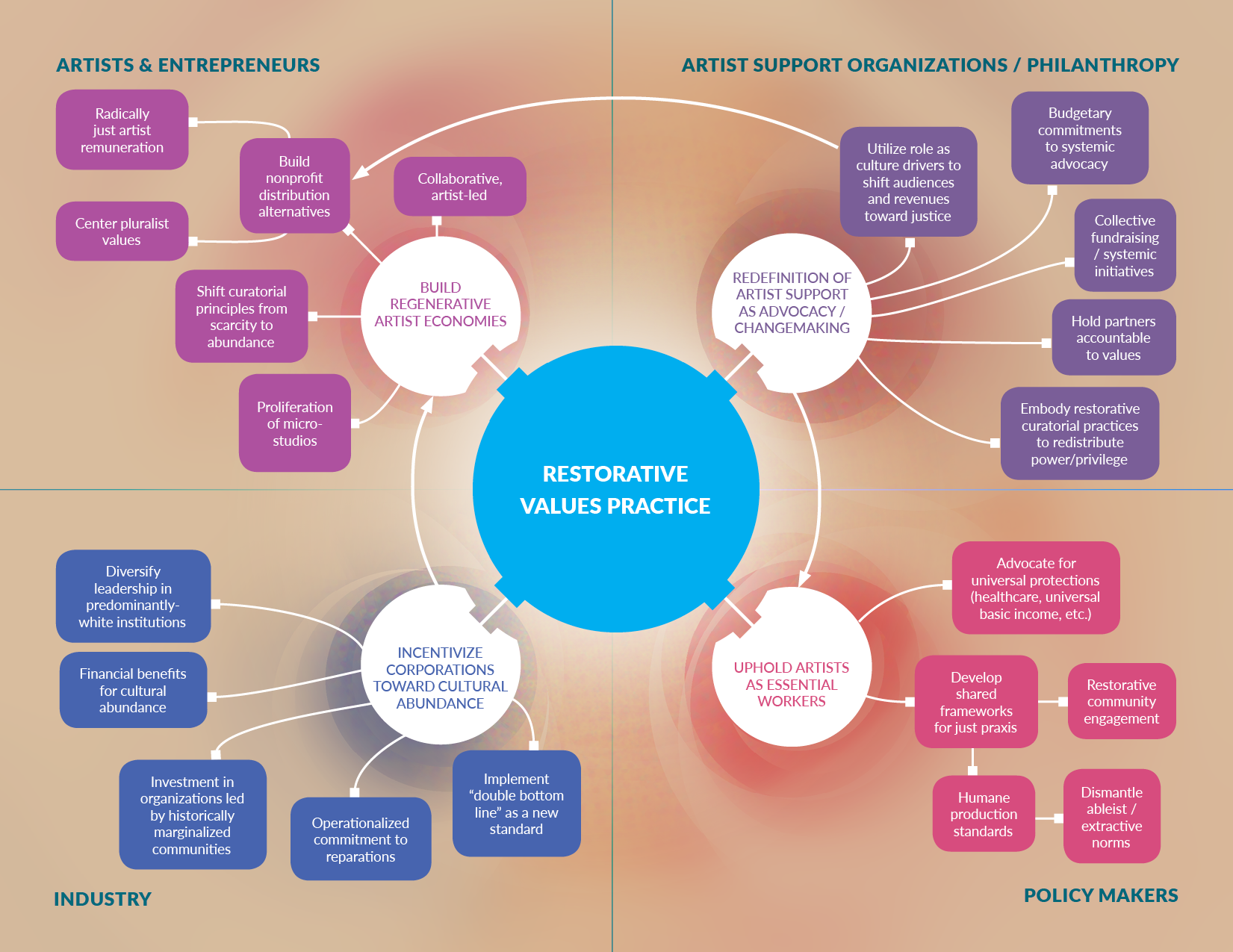The Origins of Restoring the Future
Karim Ahmad, Restoring the Future
What is the role of an artist support organization? What should it be? These were the generative questions that several of us, as culture workers, asked ourselves in the early days of the Pandemic. Many of us were representatives of these very organizations, myself included at the time, and we had built careers and lives around facilitating the artistic voices from those marginalized communities to which we all belonged - artistic voices that were disproportionately harmed during the closures and stoppages in the media arts system in 2020. As self-professed “artist supporters,” we felt we and many others had an opportunity to do better.
Many of us were and are also artists ourselves, and had long experienced first hand the exclusionary and extractive nature of the media arts system, in all its forms across all sectors - from studios and networks to the public sector to those very nonprofit organizations which employed us. This is the system functioning as it was designed – as a business, and one which disproportionately rewards those with privilege, where the value proposition of any entity within this system is to amass as much wealth as possible while giving only as much as necessary in return to those that create the art that generates that wealth.
“So why can’t we now choose to build a new foundation upon which to inform the mechanisms that create art, culture, and ultimately meaningful social progress? A structural foundation whose value proposition replaces extraction with restoration? A foundation that checks the maximization of shareholder value against maximum good of the commons and the planet? A foundation which centers and repairs the centuries-old harm inflicted upon those most marginalized in our society?”
And yet, at what point did we as artists and culture workers choose that the means by which we make and proliferate art—art which drives culture, which in turn drives society—must function unilaterally under these structures of capitalism? The answer, of course, is we did not, nor have we yet actively chosen an alternative. So why can’t we now choose to build a new foundation upon which to inform the mechanisms that create art, culture, and ultimately meaningful social progress? A structural foundation whose value proposition replaces extraction with restoration? A foundation that checks the maximization of shareholder value against maximum good of the commons and the planet? A foundation which centers and repairs the centuries-old harm inflicted upon those most marginalized in our society? A foundation which seeks to replace the false construct of a bottlenecked meritocracy with the conditions for all artists to thrive and to proliferate as many vital voices into culture as possible, thus realizing the promise of a healthier, pluralist society? What could that foundation look like? What could that media arts system look like? What could that world look like? This is the future we sought to design and map in the Restoring the Future report—a field intervention designed to spark the beginning of a hard reboot of our industry.
Image from Restoring the Future report of systemic redesign across the media arts ecosystem.
At its core, the Restoring the Future report is an exercise in collective worldbuilding and collaborative future architecture. Inspired by practices cultivated within the Guild of Future Architects, and facilitated by myself and Tony Patrick, we brought together over thirty field leaders to envision a media arts industry that centered restorative justice practices in order to acknowledge and begin to repair centuries old harm systemically perpetuated against historically marginalized communities, by centering six provocations.
These provocations were designed to be a foundation upon which individuals and institutions across all sectors of the industry can design and prototype new values and practices for themselves, and with our support. They are as follows:
As a media arts system, all sectors must eschew extraction and place restorative values practice at the core of all institutional design.
We must build regenerative and universally accessible economic models that allow artists to equitably remunerate themselves for their work, and build long term wealth.
We must uphold artists as drivers of cultural power and societal progress, and thus as essential workers, deserving of substantial protections.
We must decolonize filmmaking practices and proliferate just practices in production.
Industry structures must redesign for cultural abundance - and we must create financial incentives to uphold those values.
Artist support institutions must invest resources in systemic change, and design for a future in which philanthropy is no longer needed.
The co-creation of this report is simply a beginning. Now, a year later, Restoring the Future has evolved into an ongoing network of culture workers who are using worldbuilding, future architecture, and industry organizing to design, prototype and proliferate new field interventions - tools, resources and frameworks rooted in restorative values and practices - to facilitate a kinder, more regenerative, and more abundant media arts system. I invite you to read the report and to join us in the work ahead.
ABOUT THE AUTHOR
Karim Ahmad (he/they) is a writer and culture strategist. He is the creator of Muslim Futures, a cross-platform anthology of stories set in radically aspirational Muslim futures, which has been supported by the Pop Culture Collaborative and Race Forward’s Butterfly Lab for Immigrant Narrative Strategy. He is the writer of the speculative fiction comic book, DIVIDE, and was the creator and showrunner of the groundbreaking science fiction series FUTURESTATES. He is also the founder of Restoring the Future, a network of culture workers who are using worldbuilding and industry organizing to build a more just and beautiful media arts system. Ahmad is a current OSF Soros Equality Fellow, a member of the Guild of Future Architects, and can be found on Twitter as @thatkarimahmad


